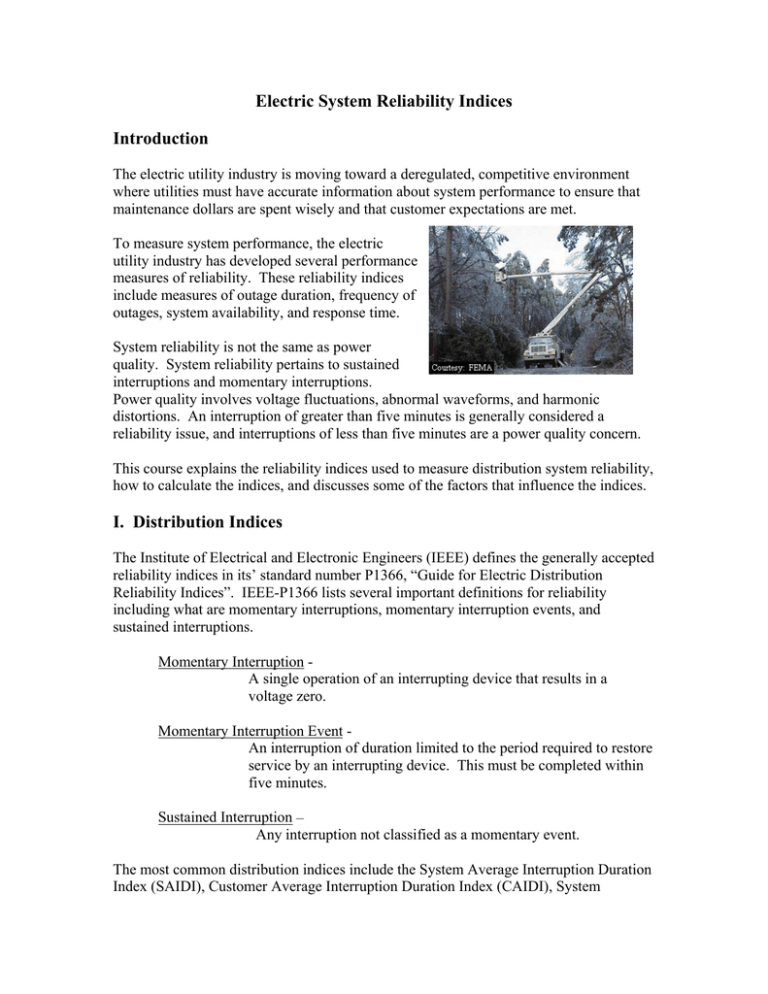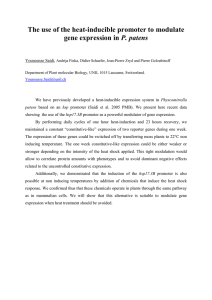
Electric System Reliability Indices
Introduction
The electric utility industry is moving toward a deregulated, competitive environment
where utilities must have accurate information about system performance to ensure that
maintenance dollars are spent wisely and that customer expectations are met.
To measure system performance, the electric
utility industry has developed several performance
measures of reliability. These reliability indices
include measures of outage duration, frequency of
outages, system availability, and response time.
System reliability is not the same as power
quality. System reliability pertains to sustained
interruptions and momentary interruptions.
Power quality involves voltage fluctuations, abnormal waveforms, and harmonic
distortions. An interruption of greater than five minutes is generally considered a
reliability issue, and interruptions of less than five minutes are a power quality concern.
This course explains the reliability indices used to measure distribution system reliability,
how to calculate the indices, and discusses some of the factors that influence the indices.
I. Distribution Indices
The Institute of Electrical and Electronic Engineers (IEEE) defines the generally accepted
reliability indices in its’ standard number P1366, “Guide for Electric Distribution
Reliability Indices”. IEEE-P1366 lists several important definitions for reliability
including what are momentary interruptions, momentary interruption events, and
sustained interruptions.
Momentary Interruption A single operation of an interrupting device that results in a
voltage zero.
Momentary Interruption Event An interruption of duration limited to the period required to restore
service by an interrupting device. This must be completed within
five minutes.
Sustained Interruption –
Any interruption not classified as a momentary event.
The most common distribution indices include the System Average Interruption Duration
Index (SAIDI), Customer Average Interruption Duration Index (CAIDI), System
Average Interruption Frequency Index (SAIFI), Momentary Average Interruption
Frequency Index (MAIFI), Customer Average Interruption Frequency Index (CAIFI),
Customers Interrupted per Interruption Index (CIII), and the Average Service Availability
Index (ASAI). We will review each of these indices with an example of how to use
them.
A. System Average Interruption Duration Index (SAIDI)
The most often used performance measurement for a sustained interruption is the System
Average Interruption Duration Index (SAIDI). This index measures the total duration of
an interruption for the average customer during a given time period. SAIDI is normally
calculated on either monthly or yearly basis; however, it can also be calculated daily, or
for any other time period.
To calculate SAIDI, each interruption during the time period is multiplied by the duration
of the interruption to find the customer-minutes of interruption. The customer-minutes of
all interruptions are then summed to determine the total customer-minutes. To find the
SAIDI value, the customer-minutes are divided by the total customers. The formula is,
SAIDI = Σ(ri * Ni ) / NT
Where,
SAIDI = System Average Interruption Duration Index, minutes.
Σ = Summation function.
ri = Restoration time, minutes.
Ni = Total number of customers interrupted.
NT = Total number of customers served.
Consider the following example. What is the SAIDI for the 28th of the month where five
outages were recorded? The table shown below shows each outage, the duration of the
outage, and the customer-hours. The utility has a total of 50,000 customers.
As you can see from the table, the first outage was at 9:53 in the morning and 10
customers where out of service for 90 minutes (1.5 hours). Therefore, the customer hours
are 10 * 1.5 or 15 hours.
///Table 1
Table 1
Calculation of Customer-Hours
Date
28th
28th
28th
28th
28th
Time Customers Duration
9:53
10
90
11:02
1,000
20
13:15
2
175
20:48
1
120
22:35
1
38
Customer
-hours
15.00
333.33
5.83
2.00
0.63
1,014
443
356.80
The customer-hours are calculated for each outage and then summed for a total of 356.80
customer-hours. Since we want to know the SAIDI calculation in minutes the customerhours must be converted to customer-minutes by multiplying by 60. The result is 356.80
* 60 = 21,408 customer-minutes.
The SAIDI is,
SAIDI = 21,408 / 50,000
SAIDI = 0.428 minutes.
This says that the average customer was out for 0.428 minutes on the 28th of the month.
If the SAIDI is calculated for each day, the monthly SAIDI is found by summing the
daily values.
B. Customer Average Interruption Duration Index (CAIDI)
Once an outage occurs the average time to restore service is found from the Customer
Average Interruption Duration Index (CAIDI). CAIDI is calculated similar to SAIDI
except that the denominator is the number of customers interrupted versus the total
number of utility customers. CAIDI is,
CAIDI = Σ(ri * Ni ) / Σ( Ni )
CAIDI = Customer Average Interruption Duration Index, minutes.
Σ = Summation function.
ri = Restoration time, minutes.
Ni = Total number of customers interrupted.
From our previous example, what is the CAIDI for the 28th?
The customer-minutes are 21,408 and 1,104 customers were interrupted on the 28th (See
Table 1). Therefore, the CAIDI is,
CAIDI = 21,408 / 1,014
CAIDI = 21.1 minutes.
On average, any customer who experienced an outage on the 28th was out of service for
21.1 minutes.
C. System Average Interruption Frequency Index (SAIFI)
The System Average Interruption Frequency Index (SAIFI) is the average number of
times that a system customer experiences an outage during the year (or time period under
study). The SAIFI is found by divided the total number of customers interrupted by the
total number of customers served. SAIFI, which is a dimensionless number, is,
SAIFI = Σ(Ni ) / NT
Where,
SAIFI = System Average Interruption Frequency Index.
Σ = Summation function.
Ni = Total number of customers interrupted.
NT = Total number of customers served.
From our previous examples, on the 28th there were 1,104 customers interrupted during 5
separate events and the total number of customers served by the utility is 50,000 so the
SAIFI is,
SAIFI = 1,014 / 50,000
SAIFI = 0.020
This says that on the 28th of the month, the customers at this utility had a 0.020
probability of experiencing a power outage. SAIFI can also be found by dividing the
SAIDI value by the CAIDI value,
SAIFI = SAIDI / CAIDI
With a SAIDI of 0.428 minutes and a CAIDI of 21.1 minutes the SAIFI is,
SAIFI = 0.428 / 21.1 = 0.020
D. Customer Average Interruption Frequency Index (CAIFI)
Similar to SAIFI is CAIFI, which is the Customer Average Interruption Frequency Index.
The CAIFI measures the average number of interruptions per customer interrupted per
year. It is simply the number of interruptions that occurred divided by the number of
customers affected by the interruptions. The CAIFI is,
CAIFI = Σ( No ) / Σ( Ni )
Where,
CAIFI = Customer Average Interruption Frequency Index.
Σ = Summation function.
No = Number of interruptions.
Ni = Total number of customers interrupted.
From our previous examples, on the 28th there were 1,104 customers interrupted during 5
separate events and the total number of customers served by the utility is 50,000 so the
CAIFI is,
CAIFI = 5 / 1,014
CAIFI = 0.005
This says that the average number of interruptions for a customer who was interrupted is
0.005 times.
E. Customer Interrupted per Interruption Index (CIII)
The Customer Interrupted per Interruption Index (CIII) gives the average number of
customers interrupted during an outage. It is the reciprocal of the CAIFI and is,
CIII = Σ( Ni ) / Σ( No )
Where,
CIII = Customer Interruption per Interruption Index.
Σ = Summation function.
No = Number of interruptions.
Ni = Total number of customers interrupted.
A total of 1,104 customers were interrupted during five separate events and the total
number of customers served by the utility is 50,000, so the CIII is,
CIII = 1,014 / 5
CIII = 203 customers
This says that, on average, 203 customers were interrupted on the 28th. Of course, on a
detailed look at the outages on the 28th, it is clear that one outage contributed to the vast
majority of the customer outages.
F. Momentary Average Interruption Frequency Index (MAIFI)
The MAIFI is the Momentary Average Interruption Frequency Index and measures the
average number of momentary interruptions that a customer experiences during a given
time period. Most distribution systems only track momentary interruptions at the
substation, which does not account for pole-mounted devices that might momentarily
interrupt a customer. MAIFI is rarely used in reporting distribution indices because of
the difficulty in knowing when a momentary interruption has occurred. MAIFI is
calculated by summing the number of device operations (opening and reclosing is
counted as one event), multiplying the operations by the number of customers affected,
and dividing by the total number of customers served. MAIFI is,
MAIFI = Σ( IDi * Ni ) / NT
Where,
MAIFI = Momentary Average Interruption Frequency Index.
Σ = Summation function.
IDi = Number of interrupting device operations.
Ni = Total number of customers interrupted.
NT = Total number of customers served.
Assume the system had six momentary substation breaker operations on the 28th. One
breaker operated twice affecting 1,015 customers and four other breakers operated once
affecting 867, 2,005, 1,500, and 1,330 customers. The utility serves 50,000 customers.
What is the MAIFI?
The sum of the breaker operations times the number of customers affected is,
Σ( IDi * Ni ) = (2* 1,105) + (1 * 867) + (1 * 2,005) + (1 * 1,330)
Σ( IDi * Ni ) = 6,412 customer-interruptions
Therefore the MAIFI is,
MAIFI = 6,412 / 50,000
MAIFI = 0.128
On average, the customers experienced 0.128 momentary interruptions on the 28th.
G. Average Service Availability Index (ASAI)
The Average Service Availability Index (ASAI) is the ratio of the total number of
customer hours that service was available during a given time period to the total customer
hours demanded. This is sometimes called the service reliability index. The ASAI is
usually calculated on either a monthly basis (730 hours) or a yearly basis (8,760 hours),
but can be calculated for any time period. The ASAI is found as,
ASAI = [1 – (Σ(ri * Ni ) / (NT * T))] * 100
Where,
ASAI = Average System Availability Index, percent.
Σ = Summation function.
T = Time period under study, hours.
ri = Restoration time, hours.
Ni = Total number of customers interrupted.
NT = Total number of customers served.
In this calculation, the restoration time, ri, is in hours instead of minutes.
What is the ASAI value for the 28th based on the outage data reported in Table 1?
From Table 1, the customer-hours are 356.80. Since only one day, the 28th, is under
study the study period is 24 hours. So, the ASAI is,
ASAI = [1 – (356.80 / (50,000 * 24))] * 100
ASAI = 99.97%
Another way of looking at ASAI on an annual basis is,
ASAI = [(8,760 – SAIDI) / 8760] * 100
From the ASAI, we see that the system has an average availability of 99.97% for the 28th.
Some utilities have set an ASAI goal of “four-nines” or 99.99% reliability. A “fournines” reliability value translates into a SAIDI of 52 minutes per year.
II. Major Events
The indices presented herein are used by utilities to measure their present performance
against past history and to compare their performance to other utilities. In some states the
public utility commissions are mandating reliability standards based on the indices and
attaching revenue
incentives to
performance. The
adjacent map of the
United States shows
the status of public
utility commission
regulatory
requirements for
distribution
reliability.
For the indices to
have meaning there
must be a
standardized
method of recording
data. Applying the
indices to routine
outages is straightforward. The issue is how do utilities separate major events from
routine occurrences? Almost all regulators allow utilities to separate major events from
routine outages. But, what is a major event?
Traditionally utilities have used rather simple measures to define major events. One such
measure is “a major event is any event that has more than 10% of the utilities customers
out of service for 24 hours.” Another definition is “15% of the customers for the duration
of the storm.” Because regulators want to tie performance to reliability, utilities are
looking for an approach that better defines when an anomaly has occurred on the system.
An IEEE working group has proposed a statistical approach to the problem to define
Major Event Days or MEDs. Their recommendation, known as the Beta Method, works
like this,
•
•
•
•
A Major Event Day (MED) is any day that exceeds a daily SAIDI threshold called
TMED.
Daily SAIDI values for the past five years are used to calculate TMED.
The natural log (ln) of each SAIDI value is found and the log-average (α) is
found.
The standard deviation of the logarithms is found (β).
From this data, TMED is,
TMED = e (α +2.5 * β)
Where,
TMED = Major Event Threshold, minutes.
e = Exponential function, 2.718.
α = Log-average of the data.
β = Log-standard deviation of the data.
For an example, consider the following chart (which only has one month’s data instead of
the recommended 60 months.)
///Table 2
From the data in table 2, we see that the total of the natural logarithms of the data is –
99.348 and with 29 days the log average is -3.4258. Using an Excel spreadsheet and the
standard deviation function (STDEV) the log-standard deviation is 2.4413. With this
data, TMED is,
TMED = e (-.3.4258 +2.5 * 2.4413)
TMED = 14.55 minutes.
From this data, the utility should only consider an event as major if the daily SAIDI
exceeds 14.55 minutes.
One of the reasons to factor out major events is to normalize the SAIDI information to
ensure that the utility is responding to real changes in its reliability indices and is not
“chasing” variances caused by major events such as hurricanes, tornadoes, and floods.
The following graph is a good example of why the major event days should be used.
///graph of impact of MEDs////
Adjusted vs. Unadjusted SAIDI
140
120
Minutes
100
10
15
45
80
Major Events
Nomalized SAIDI
60
40
95
93
2001
2002
85
20
0
2003
From this graph we can see that 2003 was the worst year for SAIDI, but 45 minutes of
the SAIDI was due to a major event. Removing the major events, the SAIDI data is
fairly consist over the past three years and even 2003 shows some improvement in
reliability.
III. Reliability Trends
There has not been much change in the reliability of the electric distribution systems
during the past few years. The chart below, which is based on data from the Electric
Power Research Institute (EPRI) shows the SAIDI values over a ten-year period
including the median value, and the upper and lower quartiles. The average SAIDI value
has hovered around 100 minutes per year while the top quartile has been slightly under
70 minutes.
///SAIDI Trends
With the advent of performance-based rates, utilities are taking a closer look at their
reliability data and working to improve their indices. Studies have shown that reliability
is greatly affected by lightning, circuit length, circuit density, and system voltage. There
is an almost direct correlation between lightning and reliability (the more lightning
flashes, the lower the reliability), as well as circuit length, with longer circuits have more
interruptions. Some data also suggests that utilities with higher system voltages tend to
have more outages, but this may be related to the length of the circuit more than the
voltage.
Circuit configuration also has an impact on system reliability. Simple overhead radial
systems have the worst reliability. Auto-looped overhead systems and underground
systems have an about equal degree of reliability, and a well-coordinated overhead
system with multiple protective devices usually results in the highest degree of reliability.
Of course, network systems provide a level of service reliability that is an order of
magnitude better than any standard distribution configuration.
Conclusion
Understanding how to correctly apply the IEEE standard reliability indices is the first
step in measuring the reliability of an electric distribution system. Major events must be
removed from the base data so that reliability measures are not distorted and to help the
utility track improvements to the electric system.
The most difficult part of using reliability indices is knowing how to interpret the data
and understanding what the performance indices are really saying about the system
performance.
© 2004 Lee Layton. All Rights Reserved.




